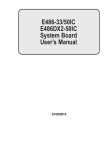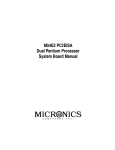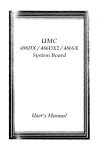Download DFI G586SP User's Manual
Transcript
G586SP G586SP AIO Rev. 0+ System Board User’s Manual - D29160226 - v Copyright 1996 by DFI, Inc. All rights reserved. No part of this document may be copied, reproduced in any form, or by any means or used to make any transformation/ adaptation without the prior written consent of DFI, Inc. DFI, Inc. makes no warranties with respect to this documentation and disclaims any implied warranties of merchantability, quality, or fitness for any particular purpose. The information in this document is subject to change without notice. DFI, Inc. reserves the right to make revisions to this publication and to make changes to any and/or all parts of its content, at any time, without obligation to notify any person or entity of such changes. Further, DFI, Inc. assumes no responsibility for any errors that may appear in this document. DFI is a registered trademark, G586SP and G586SP AIO are trademarks of Diamond Flower, Inc. All other product names mentioned are trademarks or registered trademarks of their respective companies. v FCC Statement on Class B This equipment has been tested and found to comply with the limits for a Class B digital device, pursuant to Part 15 of the FCC rules. These limits are designed to provide reasonable protection against harmful interference when the equipment is operated in a residential installation. This equipment generates, uses and can radiate radio frequency energy and, if not installed and used in accordance with the instruction manual, may cause harmful interference to radio communications. However, there is no guarantee that interference will not occur in a particular installation. If this equipment does cause harmful interference to radio or television reception, which can be determined by turning the equipment off and on, the user is encouraged to try to correct the interference by one or more of the following measures: • Reorient or relocate the receiving antenna. • Increase the separation between the equipment and the receiver. • Connect the equipment into an outlet on a circuit different from that to which the receiver is connected. • Consult the dealer or an experienced radio TV technician for help. Notice: 1. The changes or modifications not expressly approved by the party responsible for compliance could void the user's authority to operate the equipment. 2. Shielded interface cables must be used in order to comply with the emission limits. vTable of Contents v Introduction ................................................................................ 6 Features and Specifications ......................................................... 7 PackageChecklist ..................................................................... 9 Installation Overview .................................................................. Preparing the Area .................................................................. Handling the System Board ....................................................... Tips in Handling the System Board ......................................... Hardware Installation ............................................................... BoardLayout ..................................................................... Memory Installation ............................................................. Installing the Modules ..................................................... Jumper Settings ................................................................. Cache Configuration ............................................................ CPU Installation ................................................................. Installation Procedure ..................................................... Clearance Requirements ................................................. FanExhaust ................................................................. Built-in Ports ...................................................................... Serial Ports ................................................................... PS/2 Mouse Port ............................................................ Parallel Port .................................................................. Floppy Disk Drive Controller.............................................. Connecting the Floppy and Hard Disk Cable .............................. Connecting the Floppy Disk .............................................. Connecting the IDE Hard Disk Interface ............................... Adding a Second IDE Hard Drive ....................................... Preparing an IDE Drive for Use .......................................... Installing Expansion Cards ........................................................ Software Installation................................................................. TroubleshootingChecklist ........................................................... 10 10 11 11 12 13 14 16 17 21 23 24 26 26 27 27 28 28 28 29 29 30 31 31 32 32 33 Award BIOS CMOS Setup Utility ................................................... StandardCMOSSetup ............................................................. BIOS Features Setup ............................................................... Chipset Features Setup ............................................................ PowerManagementSetup......................................................... PCI Configuration Setup ........................................................... Load BIOS Defaults ................................................................. Load Setup Defaults ................................................................ Password Setting .................................................................... IDE HDDAuto Detection ........................................................... HDD Low Level Format ............................................................. Save & Exit Setup ................................................................... Exit Without Saving .................................................................. 34 35 38 39 40 41 42 42 42 43 46 47 47 System Error Report ................................................................. 48 AppendixA:Award BIOS Hard Disk Table ....................................... Appendix B: Memory & I/O Maps ................................................... Appendix C: PCI I/O Pin Assignments ............................................ Appendix D: ISA I/O Pin Assignments ........................................... AppendixE:SystemOverview ...................................................... AppendixF:ConnectorPinAssignments ....................................... AppendixG:VGAMPEGSupportModeList .................................... 52 54 56 57 58 61 72 G586SP/G586SP AIO v Introduction The G586SP/G586SP AIO system board offers several advanced features integrated into the system board. Its design is based on the new Peripheral Component Interconnect (PCI) local bus and Industry Standard Architecture (ISA) standards. The G586SP/G586SP AIO system board provides a 321-pin Zero Insertion Force (ZIF) CPU socket for PentiumTM processors running at 75MHz, 90MHz, 100MHz, 120MHz, 133MHz or 150MHz frequencies. This ZIF socket allows users to easily upgrade CPUs. The difference between the G586SP and G586SP AIO is that the G586SP AIO comes with a built-in video accelerator for ultimate graphic displays. The VGA controller can display graphic resolutions up to 1024 x 768, 256 colors, 75Hz at 1MB DRAM, and up to 1280x1024, 256 colors, 60Hz at 2MB DRAM. The built-in VGA function also supports video playback, VESA DDC1 and DDC2B. Both the G586SP and G586SP AIO are equipped with three dedicated PCI slots, two dedicated ISA slots, and one shared PCI/ISA slot. The board has two bus master PCI IDE connectors. Bus mastering reduces CPU utilization during disk transfer resulting more efficient use of CPU resources. The system board is also equipped with two NS16C550A-compatible serial ports, one SPP/ECP/EPP parallel port, one analog VGA port (G586SP AIO model only), a floppy disk drive controller, and one PS/2 keyboard or AT keyboard connector. The board can support 2MB to 256MB of EDO or fast page mode DRAM (x32 or x36, 60 or 70ns) using 72-pin SIMMs (Single In-line Memory Module). 6 G586SP/G586SP AIO Features and Specifications Processor • Intel® PentiumTM Processor 75/90/100/120/133/150MHz • Future PentiumTM OverDrive Processor Chipset • SiS chipset: SiS5511: PCI/ISA system and cache memory controller SiS5512: PCI local data buffer SiS5513: PCI system I/O SiS6205 PCI graphics and video accelerator (G586SP AIO) • Winbond W83787F/83877F super I/O controller System Design • Unified Memory Architecture (G586SP AIO): 64-bit main memory is shared between the CPU and the graphics controller • Four 72-pin SIMM sockets • 2MB to 256MB onboard memory • Uses EDO or fast page mode x32 or x36 DRAM, 60 or 70ns • Supports 256KB, 512KB, or 1MB L2 cache, direct-map WB or WT • Uses 32Kx8, 64Kx8, or 128Kx8 SRAM • Onboard asynchronous SRAM cache • Uses Intel® COAST-compatible (Rev. 1.2) 160-pin cache module slot for optional pipelined burst or synchronous cache • Award BIOS, Windows 95 Plug and Play compatible • Flash EPROM for easy BIOS upgrades Energy Efficient Design • System power management supported • CPU stopped clock control • Hardware supports SMI green mode • Microsoft/Intel APM 1.1 compliant 7 G586SP/G586SP AIO • Four power saving modes: Normal, Doze, Sleep, and Suspend High-Performance 64-Bit Graphics Accelerator (G586SP AIO) • Accelerated 64-bit graphics controller • Built-in video accelerator • Supports VESA DDC1 and DDC2B • Graphic resolutions (Non-interlaced mode): 1MB: 640x480, 16M colors, 60Hz 800x600, 64K colors, 60Hz 1024x768, 256 colors, up to 75Hz 2MB: 640x480, 16M colors, 75Hz 800x600, 16M colors, 75Hz 1024x768, 64K colors, 75Hz 1280x1024, 256 colors, 60Hz Two Bus Master PCI IDE Connectors • PIO Mode 3 & 4 Enhanced IDE (data transfer rate up to 16.6MB/sec.) • DMA Mode 2 Bus Master IDE (data transfer rate up to 22.2MB/sec.) • Bus mastering reduces CPU utilization during disk transfer • ATAPI IDE CD-ROM supported I/O Interface • Winbond super I/O controller • Supports 360KB, 720KB, 1.2MB, and 1.44MB floppy drives • Two NS 16C550A-compatible enhanced serial ports • One SPP/ECP/EPP parallel port • One analog VGA port (G586SP AIO) Mouse/Keyboard Connectors • One mini-DIN-6 PS/2 or AT keyboard connector • Option: DIP 6-pin PS/2 mouse connector 8 G586SP/G586SP AIO Expansion Slots • Three dedicated PCI slots • Two dedicated 16-bit ISA slots • One shared ISA/PCI slot PCI Bus Master Drivers • DOS 5.0 - 6.x • Windows 95, Windows 3.x • Windows NT • OS/2 2.x • Novell NetWare 3.1x, 4.x • SCO 2.x, UNIX 3.x CPU Socket • 321-pin ZIF socket (Intel Socket 7) • Option: VRM header PCB • 280mm (11.02") x 220mm (8.66") Package Checklist The G586SP/G586SP AIO package contains the following items: • • • • • • • • • • • G586SP/G586SP AIO system board G586SP/G586SP AIO user’s manual One 34-pin floppy disk drive cable One 40-pin hard disk drive cable One 25-pin printer port cable for chassis mounting One card-edge bracket with serial port cable One 16-pin cable for the VGA connector One set of IDE software drivers One set of VGA drivers (G586SP AIO only) Option: PS/2 mouse port cables Option: Cache module If any of these items is missing or damaged, please contact your dealer or sales representative for assistance. 9 G586SP/G586SP AIO v Installation Overview This chapter summarizes the steps in installing the board into your system unit. It also includes a description of the area in which you must work and directions for memory installation. Before installing the system board, obtain the memory you plan to install. Please refer to the memory chart on page 9 for the type of SIM modules needed. Note: Do not use 5V SRAM cache as they will not function properly on the system board. Preparing the Area Before unpacking the system board, make sure the location you have selected is free of dust and static electricity. Excessive exposure to dust, static electricity, direct sunlight, excessive humidity, extreme cold, and water can damage the operational capabilities of your system board. Avoid placing the unit on surfaces such as carpeted floors. These areas also attract static electricity which can damage some circuits on your system board. Make sure the power source has a properly grounded, threepronged socket. It is essential that the power connection be properly grounded for correct functioning of your system board. For further protection, we recommend that you use a surge suppressor. This will protect the system board from damage that may result from a power surge on the electrical line. Move items that generate magnetic fields away from your system board since magnetic fields can also damage your system board. Once you have selected the ideal location, unpack the system board carefully. 10 G586SP/G586SP AIO Handling the System Board Static electrical discharge can damage computer components without causing any signs of physical damage. You must take extra care in handling the system board to ensure against electrostatic buildup. Tips in Handling the System Board 1. To prevent electrostatic buildup, leave the board in its antistatic bag until you are ready to install it. 2. Wear an antistatic wrist strap. 3. Do all preparation work on a static-free surface with components facing up. 4. Hold the system board by its edges only. Be careful not to touch any of the components, contacts or connections, especially gold contacts, on the board. 5. Avoid touching the pins or contacts on all modules and connectors. Hold modules and connectors by their ends. Warning: Electrostatic discharge (ESD) can damage your processor, disk drives, add-in boards, and other components. Perform the upgrade instruction procedures described at an ESD workstation only. If such a station is not available, you can provide some ESD protection by wearing an antistatic wrist strap and attaching it to a metal part of the system chassis. If a wrist strap is unavailable, establish and maintain contact with the system chassis throughout any procedures requiring ESD protection. 11 G586SP/G586SP AIO Hardware Installation The following summarizes the basic installation instructions. Before installing the system board into your system unit, you should prepare the tools you will need one medium size, flatblade screwdriver and one medium Phillips screwdriver. 1. Unlock your system unit. Turn off the power and disconnect all power cords and cables. 2. Remove the system unit cover. Refer to the manufacturer’s instructions if necessary. 3. Remove expansion cards seated in any of the expansion slots and detach all connectors from the old system board. 4. Loosen the screws holding the original system board and remove the board from the system. Save the screws. 5. Remove the system board from its original packing box. Be careful to avoid touching all connectors and pins on the board. Please refer to the handling instructions on page 6 for proper handling techniques. 6. Insert the SIMMs into the SIMM banks on the system board. The quantity and location of the SIMMs is dependent upon the memory configuration and type of modules you intend to use. 7. Install the CPU. Be sure pin 1 of the CPU is aligned with pin 1 of the socket. 8. Set the corresponding jumpers. 9. Install the prepared system board into the case and replace the screws. 10. Reinstall all cards and connectors and replace the system unit cover. Reconnect all power cords and cables. 12 G586SP/G586SP AIO Board Layout 13 G586SP/G586SP AIO Memory Installation The system board supports 2MB to 256MB of memory using 72-pin SIMMs (Single In-line Memory Module) with the following two types of memory and sizes: (1) Single-sided SIMMs: 1MB, 4MB, 16MB, and 64MB; (2) Double-sided SIMMs: 2MB, 8MB, and 32MB. The SIM sockets are divided into two banks on the system board. Each bank consists of 2 SIMM sockets. The board uses x32 or x36, 60 0r 70ns SIMMs. You will need 2 or 4 pieces of SIM modules, depending on the amount of memory you intend to install. The following table summarizes the bank locations and possible memory configurations: Bank0 MemorySize Bank1 SIMM1 SIMM2 SIMM3 SIMM4 4MB 1Mx36 — — — 8MB 2Mx36 — — — 16MB 4Mx36 — — — 32MB 8Mx36 — — — 64MB 16Mx36 — — — 2MB 256Kx36 256Kx36 — — 4MB 256Kx36 256Kx36 256Kx36 256Kx36 4MB 512Kx36 512Kx36 — — 6MB 512Kx36 512Kx36 256Kx36 256Kx36 8MB 512Kx36 512Kx36 512Kx36 512Kx36 8MB 1Mx36 1Mx36 — — 32-bit mode 64-bit mode 14 G586SP/G586SP AIO Bank1 Bank0 MemorySize SIMM1 SIMM2 SIMM3 SIMM4 10MB 1Mx36 1Mx36 256Kx36 256Kx36 12MB 1Mx36 1Mx36 512Kx36 512Kx36 16MB 1Mx36 1Mx36 1Mx36 1Mx36 16MB 2Mx36 2Mx36 — — 18MB 2Mx36 2Mx36 256Kx36 256Kx36 20MB 2Mx36 2Mx36 512Kx36 512Kx36 24MB 2Mx36 2Mx36 1Mx36 1Mx36 32MB 2Mx36 2Mx36 2Mx36 2Mx36 32MB 4Mx36 4Mx36 — — 34MB 4Mx36 4Mx36 256Kx36 256Kx36 36MB 4Mx36 4Mx36 512Kx36 512Kx36 40MB 4Mx36 4Mx36 1Mx36 1Mx36 48MB 4Mx36 4Mx36 2Mx36 2Mx36 64MB 4Mx36 4Mx36 4Mx36 4Mx36 64MB 8Mx36 8Mx36 — — 66MB 8Mx36 8Mx36 256Kx36 256Kx36 68MB 8Mx36 8Mx36 512Kx36 512Kx36 72MB 8Mx36 8Mx36 1Mx36 1Mx36 80MB 8Mx36 8Mx36 2Mx36 2Mx36 96MB 8Mx36 8Mx36 4Mx36 4Mx36 128MB 8Mx36 8Mx36 8Mx36 8Mx36 128MB 16Mx36 16Mx36 — — 130MB 16Mx36 16Mx36 256Kx36 256Kx36 15 G586SP/G586SP AIO Bank0 Bank1 MemorySize SM3 SM4 SM1 SM2 132MB 16Mx36 16Mx36 512Kx36 512Kx36 136MB 16Mx36 16Mx36 1Mx36 1Mx36 144MB 16Mx36 16Mx36 2Mx36 2Mx36 160MB 16Mx36 16Mx36 4Mx36 4Mx36 192MB 16Mx36 16Mx36 8Mx36 8Mx36 256MB 16Mx36 16Mx36 16Mx36 16Mx36 Installing the Modules A SIM module simply snaps into a socket on the system board. Pin 1 of the SIM module must correspond with Pin 1 of the socket. 1. Position the SIMM above the socket with the “notch” in the module aligned with the “key” on the socket. 2. Seat the module at a 45o angle into the bank. Make sure it is completely seated. Tilt the module upright until it locks in place in the socket. 16 G586SP/G586SP AIO Jumper Settings Jumpers JP7 & JP8, and JP20 & JP21 CPU External Clock Speed and CPU Internal/External Speed Ratio CPU Speed CPU External JP7 JP8 Speed 50MHz 60MHz 66MHz 60MHz 66MHz 60MHz 66MHz 60MHz 66MHz 75MHz 90MHz* 100MHz 120MHz 133MHz 150MHz 166MHz 180MHz 200MHz On On Off On Off On Off On Off On Off On Off On Off On Off On Frequency JP20 JP21 Ratio 1.5x 1.5x 1.5x 2x 2x 2.5x 2.5x 3x 3x Off Off Off Off Off On On On On Off Off Off On On On On Off Off Jumper JP16 CPU Voltage Type Set JP16 pins 1-2 On if the voltage of your CPU is 3.3V (Std/VR). Set JP16 pins 3-4 to On if the voltage of your CPU is 3.45 (VRE), which is the default setting. Jumpers JP10 and JP11 Onboard Cache Memory Jumper 256KB* 512KB 1MB JP10 JP11 1-2 On 1-2 On 1-2 On 2-3 On 2-3 On 2-3 On *Default 17 G586SP/G586SP AIO Cache Size Data SRAM 256KB 512KB 1MB 32KBx8x8 64KBx8x8 128KBx8x8 Tag SRAM 8KBx8x1 16/32KBx8x1 32KBx8x1 Cacheable Range 8 Tag Bits 7 Tag Bits 1 Dirty Bit 64MB 128MB 256MB 32MB 64MB 128MB Note: You can change the cacheable range settings by using the “L2 (WB) Tag Bit Length” option in the Chipset Features Setup of the Award BIOS utility. Jumper JP14 Cache Type Set JP14 pins 1-2 to On if your system board is installed with asynchronous cache SRAM. Set pins 2-3 to On if the system board is installed with burst/pipeline burst cache SRAM. The default is set to pins 2-3 On. If you are installing a cache module, make sure the cache chips have been removed from the SRAM sockets. Jumper JP18 L1 Cache Mode Jumper JP18 is used to select the level 1 cache mode. Set pins 1-2 to On for write-back cache and pins 2-3 to On for write-through cache. The default is write-back cache. If you change the setting of JP18, the “L1 Cache Update Mode” option in the Chipset Features Setup menu of the BIOS utility must be changed accordingly. 18 G586SP/G586SP AIO Jumper JP2 Display Type Select Jumper JP2 sets the display adapter to color or mono. The default setting is On which is on the color mode. This jumper must match the type of display adapter installed. If you change your video adapter, make sure this jumper is changed accordingly. Jumper JP3 PS/2 Mouse The G586SP/G586SP AIO package includes a card-edge bracket with serial and mouse port. If you set JP3 to On, Enabled, make sure you connect the PS/2 mouse port to Connector J3. The default is set to On, enabled. If you want to disable this function, set JP3 to Off. Jumper JP5 (G586SP AIO only) Onboard VGA Interrupt Set JP5 to On, VGA interrupt enabled, only when using the VGA feature connector. By enabling JP5, you will lose INTA# of PCI Slot 1. The default is set to Off, disabled. Jumper JP6 PCI Bus Clock The default of jumper JP6 is Off, CPU Bus Clock/2. If JP6 is set to Off, the CPU’s external speed will be divided into 2. You can set JP6 to On, 32MHz, if you are using a 75MHz CPU. Jumper JP9 Internal/External Battery Selection The system board comes with an internal lithium battery. The default setting is set to Off for battery conservation during shipment of the board. If you wish to use the internal lithium battery, set JP9 to On. Leave JP9 in its default setting, Off, if you wish to use an external lithium battery (3.6V). 19 G586SP/G586SP AIO Jumper JP12 Password/CMOS Clear If you set a password in the CMOS “Password Setting” option and forgot your password, you can use the CMOS Clear function to return the CMOS back to default and reset your password. To reset your password, first power off the computer and set pins 2-3 to On. Wait at least one minute and set pins 1-2 to On, then turn on your computer. The password has now been cleared and the CMOS is back to its default. You may enter a new password and/or change to a new setting. Jumper JP13 Flash EPROM Type Set JP13 pins 1-2 to On if you are using a 5V Flash EPROM (29F010/29EE010). Set pins 2-3 to On if you are using a 12V Flash EPROM (28F010). 20 G586SP/G586SP AIO Cache Configuration The system board supports 3.3V pipeline burst or asynchronous cache SRAM installed in the 160-pin cache module slot. The board can be configured to the following cache sizes: 256KB, 512KB, or 1MB. Installing the Cache Module 1. Locate the 160-pin cache module slot on the system board. Position the cache module above the slot. Make sure pin 1 of the cache module is aligned with pin 1 of the slot. Carefully slide the module into the slot. Press firmly on top of it to seat it properly. Note: Do not use 5V SRAM as they will not function properly. You must first remove the onboard SRAM and/or TAG SRAM and select the appropriate module type on JP14 before installing the cache module. 21 G586SP/G586SP AIO 2. Once the cache module has been installed, make sure the “External Cache” option in the BIOS Features Setup menu of the Award PnP BIOS CMOS Setup Utility is set to “Enabled”. Note: With the cache module installed in the cache module slot, the length of the add-on card in PCI Slot 4 is limited to 205 mm only if its components protrude more than 5 mm from the components and/or solder side of the card. 22 G586SP/G586SP AIO CPU Installation The system board is equipped with a 321-pin Zero Insertion Force (ZIF) socket (see page 8 for socket location). This socket is designed for easy removal of an old CPU and easy insertion of an upgrade CPU. If you need to apply excessive force to insert the CPU, you are not installing the CPU correctly. Warning: Open the socket only if you are actually installing a CPU. The warranty on the original CPU will be voided if the S/N seal is broken. Do not change any factory CPU speed jumper settings. You do not need to change any jumpers to properly install the 3.3V Pentium Upgrade Processor. Before proceeding with the upgrade, take note of the following. The microprocessor and heat sink may be hot if the system has been running. To avoid the possibility of a burn, power the system off and let the processor and heat sink cool for 10 minutes. The 321-pin ZIF socket consists of five rows of pin holes on each side. To prevent improper OverDrive Processor installation, the ZIF socket has a Plug/Keying mechanism. Several holes in the socket are plugged so that OverDrive Processors will go in only one way. If you cannot easily insert the OverDrive Processor, verify that pin 1 of the CPU is aligned with pin 1 of the socket. Be extremely careful to match pin 1 of the CPU with pin 1 of the socket. Only Intel's OverDrive Processor is keyed to prevent improper placement in the ZIF socket. Other Intel CPUs, as well as CPUs from other vendors, can be placed incorrectly and will be permanently damaged if incorrectly placed. Usually, pin 1 of the CPU is marked by a dot or a cut corner. 23 G586SP/G586SP AIO Installation Procedure To install a CPU, do the following. 1. Make sure the handle on the side of the ZIF socket is up. To raise the handle, push it down, slightly pull it out to the side, then raise it as far as it will go. The top plate will slide back. Do not use screwdrivers or other tools to open the socket, or you may damage the system or socket. It may be necessary to initially apply a small amount of sideways force to free the handle from its retaining “tab.” Once clear of the “tab,” the handle will open relatively easily. 2. Once the lever is completely up, remove the old CPU by carefully lifting it straight out of the socket. You are now ready to insert the new CPU. 24 G586SP/G586SP AIO 3. Position the CPU above the ZIF socket. Make sure pin 1 of the CPU is aligned with pin 1 of the socket. Lower the chip until the pins are inserted properly in their corresponding holes. Remember that very little force is needed to install the CPU. If the CPU will not insert easily, verify pin 1 of the CPU is aligned with pin 1 of the socket. Applying too much pressure can damage the CPU or the socket. 4. Push the handle down until the handle locks into place. The top plate will slide forward. You will feel some resistance as the pressure starts to secure the CPU in the socket. This is normal and will not damage the CPU. However, if the handle is not completely closed, damage to the CPU and/or system board may result. 25 G586SP/G586SP AIO Clearance Requirements The 3.3V Pentium OverDrive Processor comes with a heat sink mounted on top. To maintain proper airflow once the upgrade is installed on the system board, the processor and heatsink require certain space clearances. The clearance above 3.3V Pentium OverDrive Processor's fan/heatsink must be at least 0.4 inches. The clearance on at least 3 of 4 sides of the processor must be at least 0.2 inches. The cables (for floppy drive, hard drive, CD-ROM, etc.) must be routed clear of the CPU and its airspace. Fan Exhaust The CPU must be kept cool by using a fan exhaust configuration in connection with the heatsink. The temperature of the air entering the fan/heatsink cannot exceed 45°C (113°F). The ambient or room temperature must be below 37°C (99°F) for a system installed with the 3.3V Pentium Upgrade Processor. In order to provide proper airflow to the CPU, all movable obstructions (power supply cables, cards, floppy disk cables) must be clear of the CPU fan/heatsink component in accordance with the space clearance discussed in the CPU installation section of this manual. 26 G586SP/G586SP AIO Built-in Ports The system board is equipped with two serial ports, one SPP parallel printer port, one FDD connector, two IDE hard disk shrouded headers, and/or one optional PS/2 mouse connector. Serial Ports The built-in serial ports are RS-232C asynchronous communication ports with 16C550A-compatible UARTs that can be used with modems, serial printers, remote display terminals, and other serial devices. They use the following system I/O addresses: (1) COM 1: 3F8h; (2) COM 2: 2F8h. Connecting the Serial Ports: J4, J5 Two DB-9P serial port cables are provided with the motherboard. They are mounted on a card-edge bracket along with the optional PS/2 mouse cable. The upper serial port cable should be used for the COM 1 primary serial port; connect it to Connector J4 on the motherboard. The lower serial port cable should be used for the COM 2 secondary serial port; connect it to Connector J5 on the motherboard. Make sure the colored stripes on the ribbon cables are aligned with pin 1 of Connectors J4 and J5. Pin 1 Stripe COM1 COM 2 Option: PS/2 Mouse Port Pin 1 J3 J4 J5 27 G586SP/G586SP AIO PS/2 Mouse Port (optional): J3 The PS/2 mouse port is a 6-pin connector on the system board. Attach the 6-pin mouse port cable to Connector J3 and make sure the brown wire on the PS/2 mouse connector aligns with pin 1 of Connector J3. Parallel Port: J8 The system board has a standard connector for interfacing your PC to a parallel printer. This port is compatible with both IBM AT printer ports and the new, high speed, bidirectional Extended Capabilities Port standard. The parallel port on your system board can be set to any of the following system I/O addresses: (1) 3BC-3BE Hex; (2) 378-37A Hex (Default); (3) 278-27A Hex. Connecting the Parallel Printer Port Attach the DB-25S printer port cable, which came with the motherboard, to Connector J8. Make sure the colored stripe on the ribbon cable aligns with pin 1 of Connector J8. Use a small nutdriver to mount the cable into a DB-25 cutout in the system chassis. Floppy Disk Drive Controller The system board has a built-in floppy disk controller that supports two standard floppy disk drives. You can install any 720KB/1.2MB/1.44MB floppy disk drives. 28 G586SP/G586SP AIO Connecting the Floppy and Hard Disk Cable: J11, J12, J13 Pin 1 Stripe Floppy Drive Connector: J11 J12: Primary IDE Connector J13: Secondary IDE Connector The Floppy and Hard Disk Connector on the System Board Connecting the Floppy Disk Step 1 Install the 34-pin header connector into the floppy disk connector (J11) on the system board. The colored edge of the ribbon should be aligned with pin 1 of connector J11. Step 2 Install the other 34-pin header connector(s) into the disk drive(s) with the colored edge of the daisy chained ribbon cable aligned with pin 1 of the drive edge connector(s). The end-most connector should be attached to the drive you want to designate as Drive A. 29 G586SP/G586SP AIO Connecting the IDE Hard Disk Interface To prevent improper IDE cable installation, each PCI IDE shrouded header has a keying mechanism. The 40-pin connector on the IDE cable can be placed into the header only if pin 1 of the connector is aligned with pin 1 of the header. PCI IDE Shrouded Header Step 1 If you are connecting two hard drives, install the 40-pin connector of the IDE cable into the primary IDE shrouded header (Connector J12). If you are adding a third or fourth IDE device, install the 40-pin connector of the other IDE cable into the secondary IDE shrouded header (Connector J13). Step 2 Install the other 40-pin header connector(s) into the device with the colored edge of the ribbon cable aligned with pin 1 of the drive edge connector(s). Note: Refer to your disk drive user's manual for information about selecting proper drive switch settings. 30 G586SP/G586SP AIO Adding a Second IDE Hard Drive When using two IDE drives, one must be set as the master and the other as the slave. Follow the instructions provided by the drive manufacturer for setting the jumpers, drive type, and/or switches on the drives. No changes are needed on the system board when adding a second hard drive. It is recommended that the IDE hard drives be from the same manufacturer. In a few cases, drives from two different manufacturers will not function properly when used together. The problem lies in the hard drives, not the system board. Preparing an IDE Drive for Use IDE disk drives are already low-level formatted, with any bad-track errors entered, when shipped by the drive manufacturer. Do not attempt to do a low-level format or you may cause serious damage to the drive. To use an IDE drive, you need to enter the drive type into the system’s CMOS setup table. Then run FDISK and FORMAT provided with DOS. Warning: Do not run FDISK and FORMAT programs on a drive that has already been formatted or you will lose all programs and data stored on the drive. 31 G586SP/G586SP AIO Installing Expansion Cards The system board is equipped with four PCI and three ISA slots. All four PCI slots are bus masters. One PCI slot and one ISA slot are shared. You can only install one card in one or the other of the shared slots at a time; you cannot install devices in both slots. Due to the size of the CPU with its accompanying heatsink/ fan component, the length of the add-in cards in PCI slots 1, 2, and 3 is limited to 205mm (measured from the bracket of the card). The length of the add-in card in PCI slot 4 is limited to 205mm only if its components protrude more than 5mm from the components and/or solder side of the card. The locations of the expansion slots are shown on page 8. Note: The BIOS needs to be configured for the PCI add-on cards installed in the PCI slots. Refer to the “PCI Configuration Setup” chapter presented in the “Initial Setup Program” section of the manual. Software Driver Installation To install the IDE and/or VGA driver and utilities supported by the system board, please refer to the "Readme" files provided in the provided diskettes. 32 G586SP/G586SP AIO v TroubleshootingChecklist If you experience difficulty with the system board, refer to the checklist below. If you still cannot isolate the problem, please contact your dealer. 1. Check the jumper settings to ensure that the jumpers are properly set. If in doubt, refer to the “Board Configuration” section. 2. Verify that all SIMMs are seated securely into the bank sockets. 3. Make sure the SIMMs are in the correct locations. 4. Check that all populated memory banks are filled with correctly sized SIMMs. 5. If your board fails to function, place the board on a flat surface and seat all socketed components (gently press each component into the socket). 6. If you made changes to the BIOS settings, reenter setup and load the BIOS defaults. 33 G586SP/G586SP AIO v Award BIOS CMOS Setup Utility After you power up your system, the BIOS message appears on your screen and the memory count begins. After the memory test, the following message will appear on the screen: Press DEL to enter setup If the message disappears before you respond, restart your system or press the “Reset” button on the front of your computer. You may also restart the system by pressing the <Ctrl> <Alt> and <Del> keys at the same time. If you do not press these keys at the correct time and the system does not boot, the following error message will appear: Press Del to enter Setup If you have set a password and selected “System” in the Security Option of the BIOS Feature Setup menu, you will be prompted for the password everytime the system is rebooted or any time you try to enter Setup. Type in the correct password and press <Enter>. If you selected “Setup” in the Security Option, you will be prompted for the password only when you try to enter Setup. Refer to the “BIOS Features Setup” section for more information. 34 G586SP/G586SP AIO Press <Ctrl> <Alt> <Esc> simultaneously or <Del> to enter the Setup utility. A screen similar to the one below will appear. ROM PCI/ISA BIO S (2A 5IDD49) CMOS S ETUP UTILITY AWARD SO FTWARE, INC. S TAND ARD CMO S SETU P PASSWORD SETTING BIO S F EATURES SETU P IDE H DD AU TO DETECTION CH IPSET FEATU RES S ETUP HD D LO W LEVEL FO RMAT P OWER MAN AGEMENT SETU P SAVE & EX IT SETU P P CI CON FIGU RATIO N S ETUP EXIT WITH OUT SAVING LOA D BIO S DEFAULTS LOA D S ETUP D EFA ULTS Esc : Q uit F10 : S ave & Exit S etup : Select Item (S hift) F 2 : Change Color Time, Date, Hard D is k Ty pe ... Use the arrow keys to highlight the option you want and press <Enter>. Standard CMOS Setup Use the arrow keys to highlight “Standard CMOS Setup” and press <Enter>, a screen similar to the one on the next page will appear. ROM P CI/IS A BIO S (2A5IDD 49) S TAN DARD CM OS SETU P AWARD SO FTWARE, INC. Date (mm:dd:yy:) : Tue, Nov 7 1995 Time (hh:mm:s s) : 11 : 42 : 28 HARD DIS KS TYP E Primary M as ter Primary S lave Secondary M as ter Secondary S lave : : : : Auto None None None Drive A Drive B : 1.44M, 3.5 in. : 1.2M, 5.25 in. Video : EGA /V GA Halt on SIZE CY LS . HEADS P RECO MP LAN DZONE SECTORS 0 0 0 0 0 0 0 0 0 0 0 0 : A ll Errors Es c : Quit F1 : Help : Select Item 0 0 0 0 0 0 0 0 MO DE LBA A UTO A UTO A UTO 0 0 0 0 Bas e Memory : Extended Memory : Other Memory : 640K 29696K 384K Total Memory : 30720K PU/PD /+ /- : M odify (Shift) F2 : Change Color 35 G586SP/G586SP AIO Date and Time This selection sets the time and date for the system. Press <F3> for the calendar. These items cannot be altered; they are detected and displayed automatically. Hard Drive Type This allows you to enter the appropriate specifications for the type of hard disk drive(s) installed in your system. Under the “Type” category, you can select Auto, User, one of 46 predefined drive specifications or None. Auto This option indicates that the parameters for your hard disk drive(s) will be automatically detected and displayed when you boot your system. By default, the LBA mode is selected for a hard disk drive larger than 528 megabytes. If you decide not to accept the LBA mode, you can either specify your selection in the “IDE HDD Auto Detection” menu, or use the User option described below. User This type is user definable and allows you to enter the specifications yourself directly from the keyboard. Six categories of information are required: Size, Cylinders, Heads, Precomp, LandZone and Sectors. This information should be provided by your hard disk vendor or system manufacturer. However, we recommend you use the “IDE HDD Auto Detection” which provides a more efficient way to setup your hard drive. 46 Predefined Drive Specifications The table in Appendix A gives complete listings of the available drive types. Please refer to your hard disk documentation for the appropriate type number. 36 G586SP/G586SP AIO None Select <None> and press <Enter> if a hard drive is not installed. Drive A and Drive B These options are used to select the type of floppy disk drives installed in your system. If neither drive is present, select “None”. Make sure you choose the correct drive type; otherwise, your system might format the device improperly. Video This is used to select the type of video adapter installed in your system. Halt on This category controls whether the system will halt in case an error is detected during power up. No Errors: The system boot will not stop for any detected errors. All Errors: The system will stop whenever the BIOS detects a nonfatal error. All, But Keyboard: The system will stop for any error except a keyboard error. All, But Diskette: The system will stop for any error except a disk error. All, But Disk/Key: The system will stop for any error except a keyboard or disk error. 37 G586SP/G586SP AIO Memory The lower right hand corner shows the base memory size, extended memory size, and the other memory size of your system. You cannot alter these items; your computer automatically detects and displays them. The Other Memory size refers to the memory located in the 640K to 1024K address space. This is the memory used for different applications. DOS uses this area to load device drivers to free base memory for application programs. When you are through making changes in the Standard CMOS Setup, press <Esc> to return to the main menu. BIOS Features Setup Use the arrow keys to highlight “BIOS Features Setup” and press <Enter>, a screen similar to the one below will appear. ROM PCI/IS A BIO S(2A5ID D49) BIOS FEATU RES SETUP AWARD S OFTWARE, INC. Virus Warning CPU Internal Cache External Cache Quick P ower On Self Test Boot S equence Sw ap Floppy D rive Boot U p Floppy Seek Boot U p NumLock StatuS Boot U p Sys tem S peed Gate A20 Option Memory P arity Check Typematic Rate Setting Typematic Rate (Chars/Sec) Typematic Delay (Msec) Security O ption PCI/VG A Palette S noop 38 : Disabled : Enabled : Enabled : Disabled : A, C : Disabled : Enabled : On : High : Fast : Disabled : Disabled :6 : 250 : Setup : Disabled Video BIOS Shadow C8000-CBFF F Shadow CC000-CFF FF Shadow D0000-D 3FFF S hadow D4000-D 7FFF S hadow D8000-D BFFF Shadow DC000-D FFF F Shadow ESC F1 F5 F6 F7 : : : : : : : Enabled Disabled Disabled Disabled Disabled Disabled Disabled : S elect Item : Q uit PU/PD /+ /- : M odify : H elp : O ld Values (Shift) F2 : Color : Load BIOS D efaults : Load Setup D efaults G586SP/G586SP AIO The Virus Warning option may be set to “Enabled” or “Disabled”. When enabled, the BIOS issues a warning when any program or virus sends a Disk Format command or attempts to write to the boot sector of the hard disk drive. If you are installing or running certain operating systems such as Windows 95, please disable the Virus Warning or the operating system may not install nor work. If you choose “System” in the Security Option, you will be prompted for a password every time you cold boot your system or access setup. If you choose “Setup”, you will be prompted for a password only when trying to access setup. Use the arrow keys to move the highlight bar to the option you wish to change or modify. Use the <Page Up>, <Page Down>, <+> or <-> keys to make the corresponding changes. Press <Esc> after making the changes to return to the main menu. Chipset Features Setup The system board uses the SiS chipset. The Chipset Features Setup allows you to modify some functions to optimize system performance. It also allows you to enable, disable or select the port address of the built-in serial ports, parallel port, floppy disk controller and hard disk controller. If you press <Enter>, a screen similar to the one below will appear. ROM PCI/ISA BIO S (2A 5IDD49) CHIP SET FEATU RES SETUP AWARD SO FTWARE, INC. Auto Configuration : Enabled L1 Cache U pdate M ode L2 Cache U pdate M ode L2 (WB) Tag Bit Length Asyn. S RAM Leadoff Tim. Asyn. S RAM Burst Tim. Sync. SRAM Leadoff Tim. DRAM RA S to CAS Delay RAS Active When Refresh CAS Delay In P osted-WR FP DRA M CA S Prec. Timing FP DRA M RA S Prec. Timing ED O CAS Pulse Width ED O CAS Precharge Time ED O MDLE Timing ED O BRDY# Timing ED O RAS Precharge Timing ED O RAMW# P ower S aving CPU Address Pipelining : WB : WB : 7bits : R4 W4 Ck : 2 Ck : 3 Ck : 3 Ck : 5 Ck : 1 Ck : 1 Ck : 4 Ck : R1 W2 Ck : 1 Ck : 1 Ck : 1 Ck : 3 Ck : Disabled : Disabled S lo w R e f r e s h ( 1 : 4 ) : D is abled I S A B u s C l oc k F re qu e n c y : P CICLK /4 S y s t e m B IO S C a c he a b le : D is abled Vi d e o B I O S C a c he a b l e : Enabled M e m o ry H o l e A t 1 5 M - 16 M : D is abled V G A S ha re d M e m o ry S i z e : 1M B V G A M e m or y C l o c k ( M H z ) : 55 ESC F1 F5 F6 F7 : Quit : Select Item : Help P U/PD/+/- : Modify : Old Values (S hift) F 2 : Color : Load BIOS Defaults : Load Setup Defaults 39 G586SP/G586SP AIO Use the arrow keys to move the highlight bar to the option you wish to change or modify. Use the <Page Up>, <Page Down>, <+> or <-> keys to make the corresponding changes. If the changes you made are incorrect or you change your mind, press <F6> or <F7> to return to the default settings. Press <Esc> after making the changes to return to the main menu. Power Management Setup Use the arrow keys to highlight “Power Management Setup” and press <Enter>. A screen similar to the one below will appear. Choosing “Enabled” in the Power Management option will allow you to set Doze Mode, Standby Mode and Suspend Mode. Choose “Disabled” if you do not want your system to enter the power saving mode. 40 G586SP/G586SP AIO PCI Configuration Setup Use the arrow keys to highlight “PCI Configuration Setup” and press <Enter>; a screen similar to the one below will appear. RO M PCI/IS A BIOS (2A5IDD 49) PCI & ON BOARD I/O SETU P AWARD S OFTWARE, INC. P nP BIO S Auto-Config. 1st Available IRQ 2nd Available IRQ 3rd Available IRQ 4th Available IRQ P CI IRQ Activated By P CI IDE IRQ M ap To Primary IDE INT# Secondary IDE INT# : Disabled : 10 : 11 :9 :5 : Level : Enabled : PCI-Auto :A :B Primary IDE Prefetch Secondary IDE Prefetch ID E Burst M ode ID E Post Write ID E HDD Block Mode : Both : Both : Disabled : Disabled : Enabled O nboard O nboard O nboard O nboard O nboard : Enabled : COM1/3F8 : COM2/2F8 : 378H/IRQ7 :No rmal CP U-PCI Post Write Rate Latency for CPU-P CI CP U-PCI Burst M em Write CP U-PCI Post Mem Write Internal P CI/ID E ID E Primary Mater P IO ID E Primary Slave PIO ID E Secondary Master PIO ID E Secondary Slave P IO : 4 Ck : 2 Ck : Disabled : Enabled : Both : Auto : Auto : Auto : Auto Serial Port 1 MIDI Serial Port 2 MIDI ESC F1 F5 F6 F7 FDD Controller Serial Port 1 Serial Port 2 Parallel Port Parallel Mode : Disabled : Disabled : Q uit : S elect Item : H elp PU /P D/+/- : M odify : O ld Values (Shift) F2 : Color : Load BIO S D efaults : Load S etup D efaults The system board supports four PCI slots. Each slot may be assigned INT A, B, C, D if the card installed in the slot requires an interrupt. Each INT may then be assigned an IRQ value. This is done automatically if the “PnP BIOS AutoConfig” option is enabled. 41 G586SP/G586SP AIO Load BIOS Defaults The “Load BIOS Defaults” option loads the troubleshooting default values permanently stored in the ROM chips. These settings are non-optimal and turn off all high performance features. You should use these values only if you have hardware problems. Highlight this option in the main screen and press <Enter>. The message below will appear. Load BIOS Defaults (Y/N)? N If you want to proceed, press <Y> and the default settings will be loaded. Load Setup Defaults The “Load Setup Defaults” option loads optimized settings from the BIOS ROM. Use the Setup default values as standard values for your system. Highlight this option on the main menu and press <Enter>. The message below will appear. Load Setup Defaults (Y/N)? N Type <Y> and press <Enter> to load the Setup default values. Password Setting If you want to set a password, make sure that the Security Option under the BIOS Features Setup is set to “System” or “Setup”. Refer to the BIOS Features Setup option for more information. Use the arrow keys to highlight the Password Setting option and press <Enter>. The message below will appear. Enter Password: 42 G586SP/G586SP AIO Type in the password. You are limited to eight characters. Type in a password that is eight characters long or shorter. When done, the message below will appear: Confirm Password: You are asked to verify the password. Type in exactly the same password. If you type in a wrong password, you will be prompted to enter the correct password again. Otherwise, enter a new password. To delete or disable the password function, simply press <Enter> instead of typing in a new password. Press the <Esc> key to return to the main menu. IDE HDD Auto Detection This option detects the hard disk parameters for the hard disk drives installed in your system. Highlight this option and press <Enter>. A screen similar to the one on the next page will appear. ROM PCI/ISA BIOS (2A 5IDD49) CM OS SETUP UTILITY AWARD SOF TWA RE, INC. HARD DIS KS TYPE SIZE CYLS. HEADS PRECOM P LA NDZ S ECTOR MOD E Primary M as ter : Select Primary Master Option (N= Skip): N OPTION S S IZE 1 (Y) 212 CY LS . HEAD S PRECOMP 683 16 65535 LANDZ SECTO RS 682 38 M ODE N ORMA L Note: Some OS es (like SCO-U NIX) mus t use " NO RMAL" for installation ESC: S kip 43 G586SP/G586SP AIO Enter your choice, and press <Enter> to accept the parameters or press <Esc> to abort. The parameters of the hard disk will be displayed in the Standard CMOS Setup. Hard Drive Mode The board supports three HDD modes: Normal, LBA and Large. If your hard disk drive does not support LBA mode, the “LBA” option will not be displayed. If your HDD has 1024 or fewer cylinders, the “Large” option will not be displayed. Normal Mode The Normal mode is the generic access mode in which neither the BIOS nor the IDE controller will make any transformations during hard-drive access. The maximum number of cylinders, heads and sectors for Normal mode are 1024, 16 and 63, respectively. no.Cylinders x no. Heads x no.Sectors x bytes per sector (1024) ( 16) ( 63) ( 512) 528 Megabyte If you set your HDD to Normal mode, the maximum accessible HDD size will be 528 Megabytes even though its physical size may be greater than that. LBA (Logical Block Addressing) Mode The LBA mode is a new HDD accessing method to overcome the 528 megabyte limitation. The number of cylinders, heads and sectors shown on the screen may not be the actual number for the HDD. 44 G586SP/G586SP AIO During the HDD accessing, the IDE controller will transform the logical address described by the sector, head and cylinder number into its own physical address inside the HDD. The maximum HDD size supported by the LBA mode is 8.4 Gigabytes. It is obtained by the following formula. no.Cylinders x no. Heads x no.Sectors x bytes per sector (1024) ( 225) ( 63) ( 512) 8.4 Gigabyte Large Mode The Large mode is the extended HDD access mode supported by the G586SP AIO system board. Some IDE HDDs have more than 1024 cylinders without LBA support (in some cases, you may not want the LBA mode). The system board provides another alternative to support these kinds of HDD. The BIOS tells the operating system that the number of cylinders is 1/2 of actual and that the number of heads is double the actual. During the disk access, the reverse conversion is done by the INT13h routine. Example of Large mode: CYLS. 1120 560 HEADS 16 32 SECTORS 59 59 MODE NORMAL LARGE Maximum HDD size: no.Cylinders x no. Heads x no.Sectors x bytes per sector (1024) ( 32) ( 63) ( 512) 1 Gigabyte 45 G586SP/G586SP AIO Note: To support LBA or Large mode, address translation software is included in the Award BIOS HDD Service Routine (INT13h). If you are running an operating system that bypasses the BIOS Int13 Service Routine, LBA and Large Mode may fail. HDD Low Level Format This option will format, set the interleave mode and do a media analysis of your hard drives. Highlight this option and press <Enter>. A screen similar to the one below will appear. H ard Disk Low Level F ormat Utility NO. C YLS . HEAD SELECT DRIVE BAD TRACK LIS T P REF ORMAT Current s elect drive is : C D RIVE : C Primary Master Primary Slave Secondary Master Secondary Slave CYLIND ER : : : : : 342 0 0 0 Up/Dow n-Select item 332 0 0 0 0 H EA D : 0 32 0 0 0 0 0 0 0 EN TER-Accept 664 0 0 0 63 0 0 0 LBA N ormal N ormal N ormal ES C-Exit/A bort Copyright (c) Award Software, Inc. 1992-94 All Rights Reserved Warning: Do not attempt to do a low-level format, or you may cause serious damage to the drive. IDE disk drives are already low-level formatted, with any bad-track errors entered, when shipped by the drive manufacturer. Use the arrow keys to select an option and press <Enter> to accept the option. Press <Esc> when done. 46 G586SP/G586SP AIO Save & Exit Setup When all the changes have been made, highlight “Save & Exit Setup” and press <Enter>. The message below will appear: Save to CMOS and Exit (Y/N)? N Type “Y” and press <Enter>. The following message will appear: Reboot System (Y/N)? N Type “Y” and press <Enter>. The modifications you have made will be written into the CMOS memory, and the system will reboot. You will once again see the initial diagnostics on the screen. If you wish to make additional changes to the setup, press <Ctrl> <Alt> <Esc> simultaneously or <Del.> after memory testing is done. Exit Without Saving When you do not want to save the changes you have made, highlight this option and press <Enter>. The message below will appear: Quit Without Saving (Y/N)? N Type “Y” and press <Enter>. The system will reboot and you will once again see the initial diagnostics on the screen. If you wish to make any changes to the setup, press <Ctrl> <Alt> <Esc> simultaneously or <Del.> after memory testing is done. 47 G586SP/G586SP AIO v System Error Report When the BIOS encounters an error that requires the user to correct something, either a beep code will sound or a message will be displayed in a box in the middle of the screen and a message PRESS F1 TO CONTINUE, CTRL-ALT-ESC or DEL TO ENTER SETUP will be shown in the information box at the bottom. POST Beep There is one beep code in BIOS. This code indicates that a video error has occurred and the BIOS cannot initialize the video screen to display any additional information. This beep code consists of a single long beep followed by two short beeps. Error Messages One or more of the following messages may be displayed if the BIOS detects an error during the POST. DISK BOOT FAILURE, INSERT SYSTEM DISK AND PRESS ENTER No boot device was found. Insert a system disk into Drive A and press <Enter>. If the system normally boots from the hard drive, make sure the controller is inserted correctly and all cables are properly attached. Also be sure the disk is formatted as a boot device. Then reboot the system. DISKETTE DRIVES OR TYPES MISMATCH ERROR RUN SETUP Type of diskette drive installed in the system is different from the CMOS definition. Run setup to reconfigure the drive type correctly. DISPLAY SWITCH IS SET INCORRECTLY The display switch on the motherboard can be set to either monochrome or color. This indicates the switch is set to a 48 G586SP/G586SP AIO different setting than indicated in Setup. Determine which setting is correct, and then either turn off the system and change the jumper, or enter Setup and change the VIDEO selection. DISPLAY TYPE HAS CHANGED SINCE LAST BOOT Since last powering off the system, the display adapter has been changed. You must configure the system for the new display type. ERROR ENCOUNTERED INITIALIZING HARD DRIVE Hard drive cannot be initialized. Be sure the adapter is installed correctly and all cables are correctly and firmly attached. Also, be sure the correct hard drive type is selected in Setup. ERROR INITIALIZING HARD DISK CONTROLLER Cannot initialize controller. Make sure the card is correctly and firmly installed in the bus. Be sure the correct hard drive type is selected in Setup. Also, check to see if any jumper needs to be set correctly on the hard drive. FLOPPY DISK CNTRLR ERROR OR NO CNTRLR PRESENT Cannot find or initialize the floppy drive controller. Make sure the controller is installed correctly and firmly. If no floppy drive is installed, be sure the Diskette Drive selection in Setup is set to NONE. MEMORY SIZE HAS CHANGED SINCE LAST BOOT Memory has been added or removed since the last boot. Enter Setup and enter the new memory size in the memory fields. MEMORY VERIFY ERROR AT... Indicates an error verifying a value already written to memory. Use the location along with your system’s memory map to locate the bad chip. 49 G586SP/G586SP AIO OFFENDING ADDRESS NOT FOUND This message is used in conjunction with the I/O CHANNEL CHECK and RAM PARITY ERROR messages when the segment that has caused the problem cannot be isolated. KEYBOARD ERROR OR NO KEYBOARD PRESENT Cannot initialize the keyboard. Make sure the keyboard is attached correctly and no keys are being pressed during the boot. If you are purposely configuring the system without a keyboard, set the error halt condition in Setup to HALT ON ALL, BUT KEYBOARD. This will cause the BIOS to ignore the missing keyboard and continue the boot. MEMORY ADDRESS ERROR AT... Indicates a memory address error at a specific location. You can use this location along with the memory map for your system to find and replace the bad memory chips. MEMORY PARITY ERROR AT... Indicates a memory parity error at a specific location. You can use this location along with the memory map for your system to find and replace the bad memory chips. OFFENDING SEGMENT This message is used in conjunction with the I/O CHANNEL CHECK and RAM PARITY ERROR messages when the segment that has caused the problem has been isolated. PRESS A KEY TO REBOOT This will be displayed at the bottom screen when an error occurs that requires a reboot. Press any key and the system will reboot. PRESS F1 TO DISABLE NMI, F2 TO REBOOT When BIOS detects a Non-Maskable Interrupt condition during boot, this will allow NMI to be disabled and continue to boot. You can also reboot the system with the NMI enabled. 50 G586SP/G586SP AIO RAM PARITY ERROR - CHECKING FOR SEGMENT Indicates a parity error in Random Access Memory. SYSTEM HALTED, (CTRL-ALT-DEL) TO REBOOT... Indicates the present boot attempt has been aborted and the system must be rebooted. Press and hold down the CTRL and ALT keys and press DEL simultaneously. 51 G586SP/G586SP AIO v Appendix A: Award BIOS Hard Disk Table Type Size Cylinders Heads Sectors Write Land Precomp Zone (MB) 1 10 306 4 17 128 305 2 20 615 4 17 300 615 3 4 5 6 30 62 46 20 615 940 940 615 6 8 6 4 17 17 17 17 300 512 512 None 615 940 940 615 7 8 9 10 11 12 13 30 30 112 20 35 49 20 462 733 900 820 855 855 306 8 5 15 3 5 7 8 17 17 17 17 17 17 17 256 None None None None None 128 511 733 901 820 855 855 319 14 15 16 42 733 7 733 20 612 4 None 17 (Reserved) 0 17 17 18 19 20 21 22 23 24 25 26 27 40 56 59 30 42 30 10 40 76 71 111 977 977 1024 733 733 306 977 1024 1224 1224 1224 5 7 7 5 7 5 4 5 9 7 11 17 17 17 17 17 17 17 17 17 17 17 300 None 512 300 300 300 0 None None None None 977 977 1023 732 732 733 336 976 1023 1223 1223 28 152 1024 15 17 None 1223 52 663 Example Model TEAC SD510, MMI 112, 5412 Seagate ST225, ST4026 Seagate ST125, Tandon TM262 Tandon TM 703 Disctron 526, MMI M125 Microscience HH725, Syquest 3250, 3425 Seagate ST4038 Seagate ST4051 Seagate ST4096 Maxtor 2085 Maxtor 2140, Priam S14 Maxtor 2190, Priam S19 G586SP/G586SP AIO Land Type Size Cylinders Heads Sectors Write Precomp Zone (MB) 29 68 1024 8 17 None 1023 30 93 918 11 17 None 1023 31 32 33 34 35 36 37 38 39 40 41 83 69 85 102 110 119 17 136 114 40 42 925 1024 1024 1024 1024 1024 1024 1024 918 820 1024 11 9 10 12 13 14 2 16 15 6 5 17 17 17 17 17 17 17 17 17 17 17 None None None None None None None None None None None 1023 926 1023 1023 1023 1023 1023 1023 1023 820 1023 42 65 1024 5 26 None 1023 43 44 40 61 809 809 6 6 17 26 None None 852 852 776 684 8 16 33 38 None None 775 685 45 100 46 203 User Defined Example Model Maxtor 1085, Micropolis 1325 Maxtor 1105 1120, 4780 Maxtor 1170 CDC 9415 Maxtor 1140, 4380 Seagate ST251 Seagate 4053 Miniscribe 3053/ 6053 Miniscribe 3053/ 6053 RLL Miniscribe 3650 Miniscribe 3675 RLL Conner CP3104 Conner CP3204 53 G586SP/G586SP AIO v Appendix B: Memory & I/O Maps Memory Map Address Name Function 0000000 to 009FFFF 640KB System Board RAM System Board Memory 00A0000 to 00BFFFF 128KB Video Display Memory Reserved for Graphics Display Memory 00C0000 to 00E7FFF 160KB I/O Expansion ROM Reserved for ROM on I/O Adapter Card 00E8000 to 00FFFFF 96KB ROM on the System Board System Board BIOS 0100000 to 3FFFFFF Maximum Memory 128MB System Board Memory 54 G586SP/G586SP AIO I/O Address Map I/O Address 000-01F 020-03F 040-05F 060-06F 070-07F 080-09F 0A0-08F 0C0-0DF 0E8 0F0 0F1 0F8-OFF 1F0-1F8 170-178 200-207 278-27F 2F8-2FF 300-31F 360-36F 378-37F 380-38F 3A0-3AF 3B0-3BF 3C0-3CF 3D0-3DF 3F0-3F7 3F8-3FF Function DMA Controller 1, 8237A-5 Interrupt Controller 1, 8259A, Master Timer, 8254-2 8742 (Keyboard Controller) Real-time Clock, NMI (Non-maskable Interrupt) Mask DMA Page Memory, 74LS612 Interrupt Controller 2, 8259A DMA Controller 2, 8237A-5 Shadow RAM and Cache Control Bit Clear Numeric Processor Extension Busy Reset Numeric Processor Extension Numeric Processor Extension Primary Fixed Disk Secondary Fixed Disk Game I/O Parallel Printer Port 2 Serial Port 2 Prototype Card Reserved Parallel Printer Port 1 SDLC, Bisynchronous 2 Bisynchronous 1 Monochrome Display and Printer Adapter Reserved Color/Graphics Monitor Adapter Diskette Controller Serial Port 1 Note: The I/O address hex 000 to 0FF are reserved for the system board I/0. Hex 100 to 3FF are available on the I/O channels. 55 G586SP/G586SP AIO v Appendix C: PCI I/O Pin Assignments B -12V TCK Ground TDO +5V +5V INTB# INTD# PRSNT1# Reserved PRSNT2# Ground Ground Reserved Ground CLK Ground REQ# +5V (I/O) AD[31] AD[29] Ground AD[27] AD[25] +3.3V C/BE[3]# AD[23] Ground AD[21] AD[19] +3.3V AD[17] C/BE[2]# Ground IRDY# +3.3V DEVSEL# Ground LOCK# PERR# +3.3V SERR# +3.3V C/BE[1]# AD[14] Ground AD[12] AD[10] Ground - 01 - 02 - 03 - 04 - 05 - 06 - 07 - 08 - 09 - 10 - 11 - 12 - 13 - 14 - 15 - 16 - 17 - 18 - 19 - 20 - 21 - 22 - 23 - 24 - 25 - 26 - 27 - 28 - 29 - 30 - 31 - 32 - 33 - 34 - 35 - 36 - 37 - 38 - 39 - 40 - 41 - 42 - 43 - 44 - 45 - 46 - 47 - 48 - 49 - A Solder Side TRST# +12V TMS TDI +5V INTA# INTC# +5V Reserved +5V (I/O) Reserved Ground Ground Reserved RST# +5V (I/O) GNT# Ground Reserved AD[30] +3.3V AD[28] AD[26] Ground AD[24] IDSEL +3.3V AD[22] AD[20] Ground AD[18] AD[16] +3.3V FRAME# Ground TRDY# Ground STOP# +3.3V SDONE SBO# Ground PAR AD[15] +3.3V AD[13] AD[11] Ground AD[09] AD[08] AD[07] +3.3V AD[05] AD[03] Ground AD[01] +5V (I/O) ACK64# +5V +5V - 52 - 53 - 54 - 55 - 56 - 57 - 58 - 59 - 60 - 61 - 62 - C/BE[0]# +3.3V AD[06] AD[04] Ground AD[02] AD[00] +5V (I/O) REQ64# +5V +5V Component Side 56 G586SP/G586SP AIO v Appendix D: ISA I/O Pin Assignments A B Gnd ResetDrv +5VDC IRQ9 -5VDC DRQ2 -12VDC OWS +12VDC Gnd -SEMEMW -SEMEMR -IOW -IOR -Dack3 -DRQ3 -Dack1 DRQ1 -Refresh CLK IRQ7 IRQ6 IRQ5 IRQ4 IRQ3 -Dack2 T/C Bale +5VDC OSC Gnd - 01 - 02 - 03 - 04 - 05 - 06 - 07 - 08 - 09 - 10 - 11 - 12 - 13 - 14 - 15 - 16 - 17 - 18 - 19 - 20 - 21 - 22 - 23 - 24 - 25 - 26 - 27 - 28 - 29 - 30 - 31 - -I/OChck SD7 SD6 SD5 SD4 SD3 SD2 SD1 SD0 -I/OChrdy AEN SA19 SA18 SA17 SA16 SA15 SA14 SA13 SA12 SA11 SA10 SA9 SA8 SA7 SA6 SA5 SA4 SA3 SA2 SA1 SA0 - 01 - 02 - 03 - 04 - 05 - 06 - 07 - 08 - 09 - 10 - 11 - 12 - 13 - 14 - 15 - 16 - 17 - 18 - SBHE LA23 LA22 LA21 LA20 LA19 LA18 LA17 -Memr -Memw SD08 SD09 SD10 SD11 SD12 SD13 SD14 SD15 C D -MemCS16 -I/OCS16 IRQ10 IRQ11 IRQ12 IRQ13 IRQ14 -Dack0 DRQ0 -Dack5 DRQ5 -Dack6 DRQ6 -Dack7 DRQ7 +5VDC -Master Gnd 57 G586SP/G586SP AIO v Appendix E: System Overview DMA Channels DMA Controller 1 DMA Controller 2 Ch0-Reserved for User Ch1-Reserved for User Ch2-Diskette Ch3-Reserved for User Ch4-Cascade for CTRL 1 Ch5-Reserved for User Ch6-Reserved for User Ch7-Reserved for User Note: DMA controller 1 supports 8-bit data transfer. DMA controller 2 supports 16-bit data transfer. Address Generation for DMA Channels 3 to 0 Source DMA Page Memory Address A23 « A16 DMA Controller 1 A15 « A0 Address Generation for DMA Channels 7 to 5 Source Address 58 DMA Page Memory A23 « A17 DMA Controller 2 A16 « A1 G586SP/G586SP AIO Page Memory Address I/O Port Address Page Memory 0081H 0082H 0083H 0087H 0089H 008AH 008BH DMA Channel 2 DMA Channel 3 DMA Channel 1 DMA Channel 0 DMA Channel 6 DMA Channel 7 DMA Channel 5 System Interrupts Interrupt Controller 1 IRQ0-Timer Output (Out 0) IRQ1-Keyboard (Output Buffer Full) IRQ2-Interrupt from INTR2 IRQ3-Serial Port 2 IRQ4-Serial Port 1 IRQ5-Parallel Port 2 or 3 * IRQ6-Diskette Controller IRQ7-Parallel Port 1 or 2 * Interrupt Controller 2 IRQ8-Realtime Clock INT IRQ9-Software Redirected to INT 0AH (IRQ2) IRQ10-Reserved IRQ11-Reserved IRQ12-PS/2 Mouse IRQ13-Coprocessor IRQ14-Primary Fixed Disk Controller (1F0) IRQ15-Secondary Fixed Disk Controller (170) * The one on-board parallel port can be configured to either Parallel Port 1, 2 or 3. Parallel Port 1 uses I/O address 3BCh, Parallel Port 2 I/O address 378h, and Parallel Port 3 uses I/O address 278H. 59 G586SP/G586SP AIO Note: The 16 levels of system interrupts have the following priority: IRQ0>IRQ1>IRQ8>IRQ9>IRQ10>IRQ11> IRQ12>IRQ13>IRQ14>IRQ15>IRQ3>IRQ4>IRQ5> IRQ6>IRQ7. System Timers Channel 0 System Timer (IRQ0) Channel 1 Refresh Request Generator (15us Rate Generator Period Signal) Channel 2 Tone Generation for Speaker Real-Time Clock 60 Address Function 00 01 02 03 04 05 06 07 08 09 0A 0B 0C 0D Seconds Second Alarm Minutes Minute Alarm Hours Hour Alarm Day of Week Date of Month Month Year Register A Register B Register C Register D G586SP/G586SP AIO v Appendix F: Connector Pin Assignments Connector J2 PS/2 Keyboard Connector Pin Function 1 2 3 4 5 6 Keyboard Data Reserved Ground +5V Keyboard Clock Reserved Connector J2 AT Keyboard Connector Pin Function 1 2 3 4 5 Keyboard Clock Keyboard Clock Not Connected Ground +5V Connector J3 PS/2 Mouse Connector Pin Function 1 2 3 4 5 6 Mouse Data Reserved Ground +5V Mouse Clock Reserved 61 G586SP/G586SP AIO J4 and J5 Primary (COM1) AND Secondary (COM2) Serial Ports Pin 1 2 3 4 5 6 7 8 9 Function DCD (Data Carrier Detect) RX (Receive Data) TX (Transmit Data) DTR (Data Terminal Ready) Ground (Signal Ground) DSR (Data Set Ready) RTS (Request to Send) CTS (Clear to Send) RI (Ring Indicator) Connector J6 12V Fan Connector 62 Pin Function 1 2 +12V Ground G586SP/G586SP AIO Connector J7 (G586SP AIO) Analog Connector Pin 1 2 3 4 5 6 7 8 9 10 11 12 13 14 15 16 Function Red Green Blue Monitor ID bit 2 (Not Used) Ground Red Return (ground) Green Return (ground) Blue Return (ground) Key Sync Return (ground) Not used DDCDAT Horizontal Sync Vertical Sync DDCCCK Not used 63 G586SP/G586SP AIO Connector J8 Parallel Printer Port Pin 1 2 3 4 5 6 7 8 9 10 11 12 13 14 15 16 17 18 19 20 21 22 23 24 25 64 Function -Strobe Data 0 Data 1 Data 2 Data 3 Data 4 Data 5 Data 6 Data 7 -Ack Busy Paper Empty Select -Autofd -Error -Init -Slctin Ground Ground Ground Ground Ground Ground Ground Ground G586SP/G586SP AIO Connector J9 Power Connector Pin Function 1 2 3 4 5 6 7 8 9 10 11 12 Power Good +5V +12V -12V Ground Ground Ground Ground -5V +5V +5V +5V 65 G586SP/G586SP AIO Connector J10 (G586SP AIO) Feature Connector 66 Pin Function 1 2 3 4 5 6 7 8 9 10 11 12 13 14 15 16 17 18 19 20 21 22 23 24 25 26 PD0 PD1 PD 2 PD 3 PD 4 PD 5 PD 6 PD 7 Enpclk EBlank EHSync EVSync Ground Ground Ground Ground EnVideo EnSync EnPclk Not used Ground Ground Ground Ground Not used Ground G586SP/G586SP AIO Connector J11 Floppy Disk Drive Connector Pin 1 2 3 4 5 6 7 8 9 10 11 12 13 14 15 16 17 18 19 20 21 22 23 24 25 26 27 28 29 30 31 32 33 34 Function Ground DENSEL Ground Reserved Ground Drate0 Ground Index Ground MTR0 Ground DR1 Ground DR0 Ground MTR1 Drate1 Dir Ground Step Ground Write Data Ground Write Gate Ground Track 0 MSEN Wr Protect Ground Read Data Ground Head Select Ground Disk Change 67 G586SP/G586SP AIO Connector J12 and J13 Primary/Secondary IDE Hard Disk Drive Connectors 68 Pin Function 1 2 3 4 5 6 7 8 9 10 11 12 13 14 15 16 17 18 19 20 21 22 23 24 25 26 27 28 29 30 31 32 33 -Reset Ground D7 D8 D6 D9 D5 D10 D4 D11 D3 D12 D2 D13 D1 D14 D0 D15 Ground Reserved Reserved Ground -IOW Ground -IOR Ground Reserved BALE Reserved Ground IRQ IOCS16 SA1 G586SP/G586SP AIO Pin Function 34 35 36 37 38 39 40 Reserved SA0 SA2 HCS0 HCS1 LED Ground Pin Function 1 2 3 4 3.6V Lithium Battery Key GND GND Connector J14 External Battery 69 G586SP/G586SP AIO Connector J17 IDE LED Pin Function 1 2 Signal LED Power Connector J18 Suspend Switch Pin Function 1 2 Signal GND Connector J19 Green LED Pin Function 1 2 Signal LED Power Connector J20 Turbo LED 70 Pin Function 1 2 Signal LED Power G586SP/G586SP AIO Connector J21 Turbo Button Pin Function 1 2 GND Signal Connector J22 Reset Switch Pin Function 1 2 Ground Reset Connector J23 Speaker Pin Function 1 2 3 4 Signal Reserved Ground +5V Connector J24 Power LED/Keylock Pin Function 1 2 3 4 5 LED Signal Reserved Ground Leylock Signal Ground 71 G586SP/G586SP AIO vAppendix G: VGA Video Playback Support Mode G586SP AIO: Shared Memory Configuration (1) 72 R e solution C o lo r s 640X480 640X480 640X480 640X480 640X480 640X480 640X480 640X480 640X480 640X480 640X480 800X600 800X600 800X600 800X600 800X600 800X600 800X600 800X600 800X600 800X600 800X600 800X600 1024X768 1024X768 1024X768 1024X768 1024X768 1024X768 1024X768 1024X768 1280X1024 1280X1024 1280X1024 640X480 640X480 640X480 640X480 640X480 640X480 640X480 640X480 640X480 640X480 640X480 640X480 16 256 256 256 32K 32K 32K 64K 64K 64K 1 6 .7 M 16 16 16 16 256 256 256 256 32K 32K 64K 64K 16 16 16 16 256 256 256 256 16 16 16 16 16 16 256 256 256 32K 32K 32K 64K 64K 64K F ram e R ate 60 60 72 75 60 72 75 60 72 75 60 56 60 72 75 56 60 72 75 56 60 56 60 60 70 75 87 I 60 70 75 87 I 60 75 87 I 60 72 75 60 72 75 60 72 75 60 72 75 VGA M emory 1MB 1MB 1MB 1MB 1MB 1MB 1MB 1MB 1MB 1MB 1MB 1MB 1MB 1MB 1MB 1MB 1MB 1MB 1MB 1MB 1MB 1MB 1MB 1MB 1MB 1MB 1MB 1MB 1MB 1MB 1MB 1MB 1MB 1MB 2MB 2MB 2MB 2MB 2MB 2MB 2MB 2MB 2MB 2MB 2MB 2MB N orm al S ize F u ll Screen V ideo O n ly ü ü ü ü ü ü ü ü ü ü ü ü ü ü ü ü ü ü ü ü ü ü ü ü ü ü ü ü ü ü ü ü ü ü ü ü ü ü ü ü ü ü ü ü ü ü ü ü ü ü ü ü ü ü ü ü ü ü ü G586SP/G586SP AIO G586SP AIO: Shared Memory Configuration (2) R e s o lu tio n C o lo rs 640X480 640X480 640X480 800X600 800X600 800X600 800X600 800X600 800X600 800X600 800X600 800X600 800X600 800X600 800X600 800X600 800X600 800X600 800X600 800X600 800X600 800X600 800X600 1024X768 1024X768 1024X768 1024X768 1024X768 1024X768 1024X768 1024X768 1024X768 1024X768 1024X768 1024X768 1024X768 1024X768 1024X768 1024X768 1280X1024 1280X1024 1280X1024 1280X1024 1280X1024 1280X1024 1 6 .7 M 1 6 .7 M 1 6 .7 M 16 16 16 16 256 256 256 256 32K 32K 32K 32K 64K 64K 64K 64K 1 6 .7 M 1 6 .7 M 1 6 .7 M 1 6 .7 M 16 16 16 16 256 256 256 256 32K 32K 32K 32K 64K 64K 64K 64K 16 16 16 256 256 256 F ram e R a te 60 72 75 56 60 72 75 56 60 72 75 56 60 72 75 56 60 72 75 56 60 72 75 60 70 75 87 I 60 70 75 87 I 60 70 75 87 I 60 70 75 87 I 60 75 87 I 60 75 87 I VGA M e m o ry 2M B 2M B 2M B 2M B 2M B 2M B 2M B 2M B 2M B 2M B 2M B 2M B 2M B 2M B 2M B 2M B 2M B 2M B 2M B 2M B 2M B 2M B 2M B 2M B 2M B 2M B 2M B 2M B 2M B 2M B 2M B 2M B 2M B 2M B 2M B 2M B 2M B 2M B 2M B 2M B 2M B 2M B 2M B 2M B 2M B N o rm a l S iz e ü ü ü F u ll Screen ü ü ü V id e o O n ly ü ü ü ü ü ü ü ü ü ü ü ü ü ü ü ü ü ü ü ü ü ü ü ü ü ü ü ü ü ü ü ü ü ü ü ü ü ü ü ü ü ü ü ü ü ü ü ü ü ü ü ü ü ü ü ü ü ü ü ü ü ü ü 73






























































































